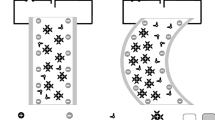Abstract
In this study, starting from the mechanism of ionic-polymer metal composites (IPMC) blocking force and displacement, the steady state of IPMC with maximum driving force is analyzed, and the mathematical model of displacement and blocking force of IPMC is established. The displacement and blocking force of Pt-IPMC are measured, and the proposed mathematical model is verified. The results show that with the increase in voltage, IPMC shows the tendency of increasing first and then decreasing. It is concluded that there is a nonlinear quartic polynomial relationship from microforce analysis between voltage and displacement, voltage and force, and the relative error verified by experiments is less than 10%. The theoretical model proposed in the paper can well reflect the relationship between voltage and displacement, and force, which provides a basis for the further application and theoretical basic modeling of IPMC.






Similar content being viewed by others
References
Y. Wang, X. Yang, Y. Chen, D.K. Wainwright, C.P. Kenaley, Z. Gong, Z. Liu, H. Liu, J. Guan, T. Wang, J.C. Weaver, R.J. Wood, L. Wen, A biorobotic adhesive disc for underwater hitchhiking inspired by the remora suckerfish. Sci. Robot. 2, eaan8072 (2017)
Z. Ren, X. Yang, T. Wang, L. Wen, Hydrodynamics of a robotic fish tail: effects of the caudal peduncle, fin ray motions and the flow speed. Bioinspir. Biomim. 11, 16008 (2016)
D. Pugal, K. Jung, A. Aabloo, K.J. Kim, Ionic polymer–metal composite mechanoelectrical transduction: review and perspectives. Polym. Int. 59, 279–289 (2010)
L. Yang, D.S. Zhang, X.N. Zhang, A.F. Tian, Fabrication and actuation of Cu-ionic polymer metal composite. Polymers 12, 460 (2020)
K.J. Kim, V. Palmre, T. Stalbaum, T. Hwang, Q. Shen, S. Trabia, Promising developments in marine applications with artificial muscles: electrodeless artificial cilia microfibers. Mar. Technol. Soc. J. 50, 24–34 (2016)
L. Yang, D. Zhang, X. Zhang, A. Tian, Prediction of the actuation property of Cu ionic polymer–metal composites based on backpropagation neural networks. ACS Omega 5, 4067–4074 (2020)
S. Guo, L. Shi, X.A. Ye, L. Li, A new jellyfish type of underwater microrobot, in 2007 International Conference on Mechatronics and Automation, Harbin, pp. 509–514 (2007)
V. Palmre, J.J. Hubbard, M. Fleming, D. Pugal, S. Kim, K.J. Kim, An IPMC-enabled bio-inspired bending/twisting fin for underwater applications. Smart Mater. Struct. 22, 014003 (2012)
A. Tripathi, B. Chattopadhyay, S. Das, Cost-effective fabrication of ionic polymer based artificial muscles for catheter-guidewire maneuvering application. Microsyst. Technol. 25, 1129–1136 (2019)
G.H. Feng, S.Y. Hou, Investigation of tactile bump array actuated with ionic polymer–metal composite cantilever beams for refreshable braille display application. Sens. Actut. A Phys. 275, 137–147 (2018)
X.L. Chang, P.S. Chee, E.H. Lim, W.C. Chong, Radiofrequency enabled ionic polymer metal composite (IPMC) actuator for drug release application. Smart Mater. Struct. 28, 015024 (2018)
M. Porfiri, An electromechanical model for sensing and actuation of ionic polymer metal composites. Smart Mater. Struct. 18, 015016 (2009)
H. Lei, X. Tan, Modeling of environment-dependent ionic polymer metal composite actuation and sensing dynamics. Ionic polymer metal composites (IPMCs): smart multi-functional materials and artificial muscles, 1, Chapter 10, pp. 334–352
D. Vokoun, Q. He, L. Heller, M. Yu, Z. Dai, Modeling of IPMC cantilever’s displacements and blocking forces. J. Bionic Eng. 12, 142–151 (2015)
M. Patel, S. Mukherjee, Modelling and analysis of ionic polymer metal composite based energy harvester. Mater. Today: Proc. 5, 19815–19827 (2018)
A. Leronni, L. Bardella, Influence of shear on sensing of ionic polymer metal composites. Eur. J. Mech. A/Solids 77, 103750 (2019)
H. Liu, K. Xiong, K. Bian, K. Zhu, Experimental study and electromechanical model analysis of the nonlinear deformation behavior of IPMC actuators. Acta. Mech. Sin. 33, 382–393 (2017)
H. Zamyad, N. Naghavi, Behavior identification of IPMC actuators using Laguerre-MLP network with consideration of ambient temperature and humidity effects on their performance. IEEE Trans. Instrum. Meas. 67, 2723–2732 (2018)
J. Khawwaf, J. Zheng, A. Al-Ghanimi, Z. Man, R. Nagarajah. Modeling and tracking control of an IPMC actuator for underwater applications, in Proceedings of the 2016 International Conference on Advanced Mechatronic Systems, Australia, pp. 550–554 (2016)
L. Yang, D. Zhang, X. Zhang, A. Tian, X. Hui, J. Yang, Fabrication of Cu/Nafion-based ionic polymer metal composites by electroless plating method. Integr. Ferroelectr. (2020). https://doi.org/10.1080/10584587.2020.1728809
Q. He, Z. Liu, G. Yin, Y. Yue, M. Yu, H. Li, K. Ji, X. Xu, Z. Dai, M. Chen, The highly stable air-operating ionic polymer metal composite actuator with consecutive channels and its potential application in soft gripper. Smart Mater. Struct. 29, 045013 (2020)
M.C. Saccardo, A.G. Zuquello, K.A. Tozzi, R. Gonçalves, L.A. Hirano, C.H. Scuracchio, Counter-ion and humidity effects on electromechanical properties of Nafion®/Pt composites. Mater. Chem. Phys. 244, 122674 (2020)
S.F. Li, J. Yip, Characterization and actuation of ionic polymer metal composites with various thicknesses and lengths. Polymer 11, 91 (2019)
E. Shoji, D. Hirayama, Effects of humidity on the performance of ionic polymer-metal composite actuators: experimental study of the back-relaxation of actuators. J. Phys. Chem. B 111, 11915–11920 (2007)
Acknowledgements
The authors acknowledge the financial assistance from the Key Science and Technology Program of Shaanxi Province, China, 2016KTZDGY-02-03.
Author information
Authors and Affiliations
Corresponding authors
Additional information
Publisher's Note
Springer Nature remains neutral with regard to jurisdictional claims in published maps and institutional affiliations.
Rights and permissions
About this article
Cite this article
Yang, L., Zhang, D., Zhang, X. et al. Models of displacement and blocking force of ionic-polymer metal composites based on actuation mechanism. Appl. Phys. A 126, 365 (2020). https://doi.org/10.1007/s00339-020-03546-x
Received:
Accepted:
Published:
DOI: https://doi.org/10.1007/s00339-020-03546-x




